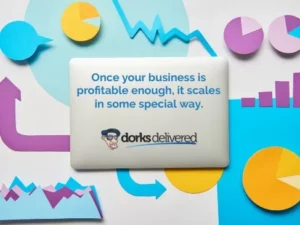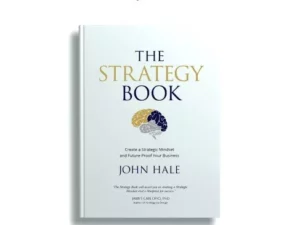We all know we need a business strategy, but a lot of the time we don’t have the time to sit down and make one. John Hale, a renowned business strategist, joined Josh to talk about how to make sure you’ve got the right strategy not only in business but also in your personal life so we can achieve balance.
What Is Strategy?
Strategic thinking is the sort of thinking that we need to do when we’re getting focused. We have lots of different thoughts. When we start to sort through the different ways we think about the world, we focus on an important aspect, or we come up with a priority for our thinking process, that starts to become strategic.
Strategy is kind of looking at the list and getting rid of everything on the list except that one thing. Michael Porter, who is the father of Modern Strategy, said that the essence of strategy is working out what not to do. We can’t really get the most important things done until we get rid of everything off our plate. Strategy begs the question: what are we going to do from the range of options available to us? The art of strategy is being able to formulate the options and then pick the right option.
Strategy in Business

A pie-maker, like most business owners, needs to think about the customer experience. What do the people who buy pies look for? People expect certain things. The sorts of pies that I ate when I was growing up wouldn’t cut the rug in some of the places you’d buy pies in Brisbane now. The taste in pies has changed.
One of the most important strategic principles is to understand and anticipate your customers’ needs so that your product or service meets a need. In terms of a pie-making business, there are several ways a pie-maker could think of to approach the marketplace.
You could provide a low-cost pie and try to appeal to a broad market. The strategy involved investing in a capability that allows you to ramp up production so you can produce thousands and thousands of pies and have a distribution network so it could scale.
Or you could choose the differentiation approach and specialise in a particular type of pie for a particular niche segment of the market, like a vegan buyer.
The other strategies have to do with how you position yourself in the market. With a choice to set up your pie shop next to another pie shop or somewhere away from the existing pie shops, traditionally, some businesses would not set up next to their competitors because the competitors will pinch their business.
Do 24 hours a day and 7 days a week seem to be not enough? Find out how our dorks can help you run your business so you can work on the business, not in it.
Strategically, it makes a lot of sense to set up right next to the other pie shops. If you get three or four pie shops on the same block in a city or town, that becomes the pie district and everybody knows that if you want pies, you go to that part of town. It grows the size of the pie (no pun intended). A pie-maker, like most business owners, needs to think about the customer experience. What do the people who buy pies look for? People expect certain things. The sorts of pies that I ate when I was growing up wouldn’t cut the rug in some of the places you’d buy pies in Brisbane now. The taste in pies has changed.
One of the most important strategic principles is to understand and anticipate your customers’ needs so that your product or service meets a need. In terms of a pie-making business, there are several ways a pie-maker could think of to approach the marketplace.
You could provide a low-cost pie and try to appeal to a broad market. The strategy involved investing in a capability that allows you to ramp up production so you can produce thousands and thousands of pies and have a distribution network so it could scale.
Or you could choose the differentiation approach and specialise in a particular type of pie for a particular niche segment of the market, like a vegan buyer.
The other strategies have to do with how you position yourself in the market. With a choice to set up your pie shop next to another pie shop or somewhere away from the existing pie shops, traditionally, some businesses would not set up next to their competitors because the competitors will pinch their business.
Strategically, it makes a lot of sense to set up right next to the other pie shops. If you get three or four pie shops on the same block in a city or town, that becomes the pie district and everybody knows that if you want pies, you go to that part of town. It grows the size of the pie (no pun intended).
Did you know that you can utilise technology to better understand your customers? Let’s talk.
McDonald’s Strategy
McDonald’s is a fascinating company to look at because it’s had to survive and reinvent itself in many respects. It’s delved in chicken and nuggets, but it didn’t quite go to the full KFC model.
To take our pie analogy a little bit further, what’s interesting is that when you look around the world, particularly in Australia, you’ll typically find a Hungry Jack’s, a KFC and a McDonald’s close to each other, and they’re often not far from a petrol station.
In Australia, we tend to clump fast food and take away with each other. When Hungry Jack’s came into the marketplace and started offering healthier burgers or better value burgers, that affected how they played the game.
In the United States 15 years ago, there was a company that came up with the fresh-and-go type of foods. At that stage, it was hard to find a decent bit of salad in most of McDonald’s offerings so there’s been pressure on them to be healthy.
Over the years, I’ve noticed that the size or portions of their burgers got smaller, which means that they’re looking at the nutritional content and they’re also looking at the calorie count. If you buy a burger that’s half the size of one that was around 1983, you’re not going to produce as many calories because you’re only selling half the product. The price went up, quantity went down, but the packaging is probably nicer, and the marketing is more impressive.
When they first started out in the United States, the real strategic value in McDonald’s franchises was the real estate locations because they would position the stores in places that may not have been particularly valuable on the map from a real estate point of view. But by being there, McDonald’s attracted other players, which raised the value of the property portfolio, and that was the real value. Mcdonald’s is the underlying value of property assets, and that was an interesting strategy. It was sort of a Trojan horse strategy.
Are you spending half of your week or more in the business? Talk to a dork to achieve time freedom with the help of technology.
Strategy and Leadership
A strategy without a team to implement is worthless, so the strategy is not going to add value. In most instances, it needs to be implemented by people, and people work well when they have powerful leadership around them.
You need to have a good leader who listens, asks good questions, and can assemble a quality team that is diverse and competent.
There’s a whole lot of emotional intelligence and ethical considerations that a senior executive team needs to think about in terms of its mix. Once you’ve got the right mix of people on the team, coming up with a strategy and then implementing it is going to be far more effective.
Leadership and strategy are both important, and they can’t exist without each other.
Strategy and Business Growth
If your idea resonates with the marketplace, then you have a value proposition. However, that’s not necessarily a strategy. That’s just a business model and a value proposition. Strategy is typically something that needs to be addressed after the business is up and running for a little while.
Do you know much time and money you could save by choosing a reliable managed service provider for all of your business’s tech needs?
1. Existence: The Early Stage of a Business
When the business exists, the priority is to source a product and find customers. Those are the two things you’ve got to do well. And those are the two priorities for any business starting out.
2. Survival: The Next Stage of Business Growth
Once you have some customers and the ability to provide a product, you move to the next stage of business growth, which I call survival. Even though you’ve got a few customers and you’re producing or sourcing a product, you haven’t made any decent profit yet. Essentially, you’re still starting out and you’re still in survival.
The survival stage is about finding more customers, and new markets. It’s about finding more efficient and better ways to source that product. You were still working on your initial value proposition. As a business owner, you’re working in the business and he business, yet you’ve got your sleeves rolled up and you are in there on the tools, doing all that stuff yourself. You haven’t got enough cash flow yet to step away and employ someone to do those tasks.
3. Success in Business
Once you get to the third stage of business growth, which is success, the business is making a genuine profit. The business is making more money than that business owner would have made if they had been employed.
Do you want to have more time to work on your business, instead of in it?
4. Takeoff: The Stage After Success

In the takeoff stage, it’s important to have a strategy because once that business gets to that critical mass where it’s making a profit, you’ve got cash flow. There are decisions that need to be made about which product we like to continue with.
Will we just keep our Wagyu pies and our vegetarian pies, or will we add other things like the lentil pie or the vindaloo curry flavoured pie? You have to decide which of the six pies you’ve developed you will scale up because you can’t scale up all of them. We might have started out with a vindaloo pie that was very popular in Brisbane, but now that the business has grown, vindaloo pies only represent 5% of the market share. If we want to grow the business, we may have to sell that recipe to someone else or just discontinue that line. That’s when we start being strategic.
We might decide that there’s an untapped market in Kangaroo pies. That’s what we’re going to invest in because we know that with the shortage of meat and the cost of cattle and the supply chain, there’s an abundance of Kangaroos out there and we’ve discovered that it’s good for the microbiome and it’s healthy for us and tourism.
5. Maturity of a Business
We might become the premium kangaroo pie company of Australia, and we might export Kangaroo pies around the world. We go from takeoff to the next stage of business growth called maturity. We now have 100 employees who bake five days a week, a dispatch bureau, and a group that negotiates with farmers and landowners around Australia to make sure we get our supply of Kangaroo.
Like success and takeoff, maturity is a messy space. You must get the technology right, you must get the people right, and you must get the strategy right. It’s not possible to go through the take-off stage on your own. As a business owner, you have to be able to delegate those things, so you get a chance to work on the business instead of in it.
Strategy is really important in those third, fourth and fifth stages of business growth, not at the early stages. The early stages are about working out the value proposition, rather than the strategy.
Develop a Strategic Mindset
John’s book The Strategy Book teaches how to cultivate a strategic mindset through a six-step process:
- Sense your environment
- See what’s coming over the hill
- Connect with customers and stakeholders
- Plan future value
- Focus
- Move
Megatrends and Radical Uncertainties
Megatrends are big forces that are going to be here for quite some time. You’re going to have to get used to them and deal with them on an ongoing basis.
Global warming is a megatrend. The world is continuing to get warmer and warmer. If you’re operating without a strategy or operating a business that doesn’t take that into account moving forward, you’re not going to survive. If you’re not doing the right thing by the planet, people won’t buy your product or service.
It’s important to understand what the megatrends are and shape strategy around them so that you can leverage the opportunity that comes from those megatrends.
Radical uncertainties are things that we can’t predict are going to happen. We don’t want to put too much money or too much strategic effort into them because we don’t know what they’re going to do. We do need to hedge against them because we don’t know when they’re going to happen, but they can happen. Examples of radical uncertainties are global finance and the fate of monopolies. Corporate lifespans keep getting shorter, and the market collapses.
Blockbuster didn’t understand that the internet was a megatrend. They didn’t understand that in 10 years, everybody would have a device connected to the Internet. They didn’t understand that computers and mobile phones would have the ability to play videos.
Review Your Business Strategy Regularly
A good example of this is Nokia. Nokia would look at the future of mobile phone technology annually. On their drawing board, they had a lot of the functionality that we eventually saw on iPhones, but they didn’t believe the market wanted it. They didn’t believe the market was ready for it, but they already had the plans in the pipeline for the sorts of things that Apple came out with.
A good example of this is Nokia. Nokia would look at the future of mobile phone technology annually. On their drawing board, they had a lot of the functionality that we eventually saw on iPhones, but they didn’t believe the market wanted it. They didn’t believe the market was ready for it, but they already had the plans in the pipeline for the sorts of things that Apple came out with.
Nokia reviewed their strategy on an annual basis, and they set their budgets on an annual basis. Apple understood that the release date for the iPhone was a month or so after they set their budgets for the coming year. They had set their strategy, they allocated their funds, they trained their teams, they worked out what projects were going to get funded, and they started to roll out the next version of their phone.
If Nokia had done their strategy on a more frequent basis, quarterly, for example, they could have responded quicker.
It’s not practical to review our strategy on a weekly or monthly basis. If it’s a highly volatile market and there’s a lot of activity going on, lots of players, then you can review your strategy on a weekly basis.
Strategy is something a lot of businesses don’t do, and they don’t do well. Whether you do it every month, every quarter, or every year, the important thing is that you do it.
Ask the Strategy Guy how do you know that you’re going in the right direction? If you are looking to cultivate a strategic mindset, talk to John Hale. Ask the Strategy Guy.































